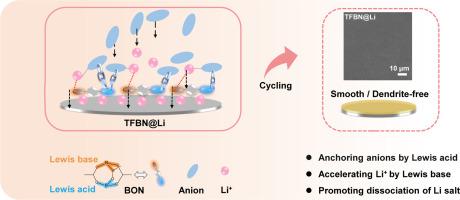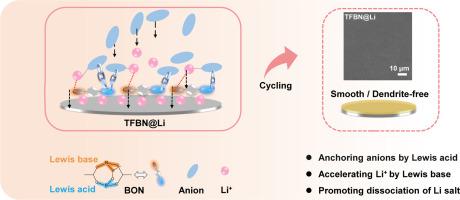基于Lewis酸/碱双址固体电解质界面的快充锂金属电池
IF 20.2
1区 材料科学
Q1 CHEMISTRY, PHYSICAL
引用次数: 0
摘要
阴离子的意外耗尽和Li+在锂阳极上的受限扩散导致了锂金属电池中不受控制的枝晶生长。固体电解质界面工程已被证明是解决这些问题的有效方法。本文利用环硼酸三异丙醇胺(BON)和LiTFSI(定义为TFBN)构建了一种具有Lewis酸/碱双位点的新型SEI层,以调节阴离子和Li+的转运行为。BON中缺电子的硼原子可以作为路易斯酸位点,锚定阴离子,防止其在界面处耗尽。同时,富电子的氮原子可以作为路易斯碱基,加速Li+的输运,促进Li的顺利沉积。因此,BON可以有效解离锂盐,调节阴离子和Li+的迁移行为。使用这种新型的SEI层,Li||Li对称电池可以在1.0 mA cm -²下实现超过1200小时的稳定循环。此外,在10℃的超高电流下,经过2000次循环后,Li||LFP充满电池的容量保持率为93.7%。本文章由计算机程序翻译,如有差异,请以英文原文为准。


Fast charging Lithium metal battery based on Lewis Acid/Base dual-site solid electrolyte interphase
The unexpected depletion of anions and the restricted diffusion of Li+ on the Li anode lead to uncontrolled dendrite growth in Li metal batteries. Solid electrolyte interphase (SEI) engineering has been proven to be an effective method for solving these issues. Herein, a novel SEI layer with Lewis acid/base dual-site is constructed with triisopropanolamine cyclic borate (BON) and LiTFSI (defined as TFBN) to regulate the transport behavior of anions and Li+. The electron-deficient boron atom in BON can serve as the Lewis acid site, which anchors the anion to prevent its depletion at the interface. Meanwhile, the electron-rich nitrogen atom can serve as the Lewis base site, which accelerates the transport of Li+ to facilitate smooth Li deposition. As a result, BON can effectively dissociate lithium salts and regulate the migration behavior of anions and Li+. Using this novel SEI layer, Li||Li symmetric batteries can achieve stable cycling for over 1200 h at 1.0 mA cm−². Furthermore, the Li||LFP full cells show 93.7 % capacity retention after 2000 cycles at an ultrahigh current of 10 C.
求助全文
通过发布文献求助,成功后即可免费获取论文全文。
去求助
来源期刊

Energy Storage Materials
Materials Science-General Materials Science
CiteScore
33.00
自引率
5.90%
发文量
652
审稿时长
27 days
期刊介绍:
Energy Storage Materials is a global interdisciplinary journal dedicated to sharing scientific and technological advancements in materials and devices for advanced energy storage and related energy conversion, such as in metal-O2 batteries. The journal features comprehensive research articles, including full papers and short communications, as well as authoritative feature articles and reviews by leading experts in the field.
Energy Storage Materials covers a wide range of topics, including the synthesis, fabrication, structure, properties, performance, and technological applications of energy storage materials. Additionally, the journal explores strategies, policies, and developments in the field of energy storage materials and devices for sustainable energy.
Published papers are selected based on their scientific and technological significance, their ability to provide valuable new knowledge, and their relevance to the international research community.
 求助内容:
求助内容: 应助结果提醒方式:
应助结果提醒方式:


